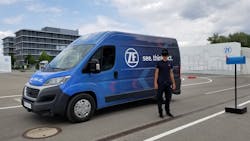We don’t know exactly what tomorrow’s mobility will look like and what role we all will play in it, but preparing our workforce plays a critical role in that.
Speaking to an audience earlier this year, Wired Magazine Editor-in-Chief Greg Williams said the job outlook growth will be in customer-related roles where emotional and social skills will be higher in demand.
An example of that potential impact on transit was seen on a recent press trip by ZF where autonomous vehicle were able to drive themselves, but it didn’t mean the elimination of a “driver” role.
The vehicles demonstrated included a delivery van and the ZF Innovation Truck, a hybrid truck based on a heavy six-wheeler.
The Innovation Van is a solution tailored to delivery couriers, incorporating autonomous driving and electromobility, with a driver doing the final delivery to the door. The vehicle is equipped with level 4 autonomous operation functions, designed to independently maneuver through urban settings and to avoid obstacles. If there is no parking available where the courier needs to deliver a package, he or she can send the vehicle ahead to look for a parking space on its own.
While the van is navigating streets to get where it needs to go, the driver can focus on coordinating delivery times with customers and work on any necessary administrative tasks.
The heavy truck driver’s most challenging tasks lie in the depot, where they need to load and unload freight, and it’s where companies see the most accidents and damage to vehicles due to driver error. The ZF Innovation Truck carried out all of the necessary tasks without a driver; the truck found its way to the target position utilizing GPS and RFID positioning. The driver is still needed to secure containers or lock parts of the trailer in place after the truck has positioned itself.
While both vehicles utilized autonomous operation, it wasn’t to try to replace a driver, it was to improve efficiency and improve safety. In both cases, the autonomous technology was targeted to address the key challenge points, while the driver’s role was adjusted to take on the other aspects of the overall task. The goal was to look at the entire process and utilize autonomous operation and a person in different roles to get the safest, most efficient overall process.
When asked about other companies showing package delivery being potentially done by drones or small autonomous robots, ZF’s Gerhard Gumpoltsberger said different companies look at the solutions in different ways. While ZF has the capability to also develop those types of solutions that wouldn’t require human involvement, he said, “The trick to tomorrow’s technology is balancing what the technology can do, with what people will accept.”



